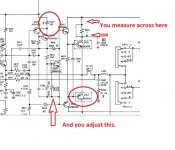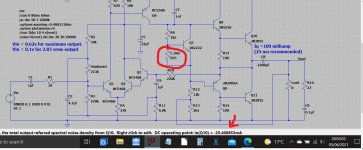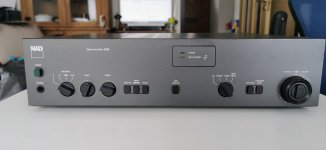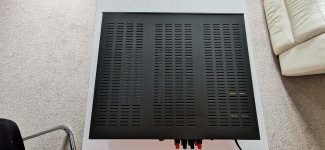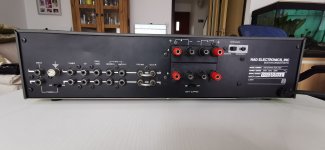Like this. The resistor is very critical and to get a little more bias current means the resistor needs reducing value by a little bit.
It can not be calculated or worked out, it is trial and error. Look at what is fitted and then determine what to do next. To reduce it you can add another in parallel but you might be looking at adding something as high as 4 or 5 k to bring the value down a fraction.
If you get this wrong the amp will draw to much current and could be damaged so always use the bulb for experimenting.
Or if you are happy with it all then leave it 🙂
It can not be calculated or worked out, it is trial and error. Look at what is fitted and then determine what to do next. To reduce it you can add another in parallel but you might be looking at adding something as high as 4 or 5 k to bring the value down a fraction.
If you get this wrong the amp will draw to much current and could be damaged so always use the bulb for experimenting.
Or if you are happy with it all then leave it 🙂
Attachments
so would it be better to change that resistor and bring it up a bit? i think the range is 26-30mvThat all sounds promising (that it is working)
RX1 and RX2 are values to adjust to get the correct bias current but you measure the voltage across R461 and R462 to determine the current.
So 0.035v across the 1 ohm gives I=V/R which is 0.035/1 giving 35 milliamps. That sounds reasonable for such an amp.
0.007 is a current of just 7 milliamps which is pretty low. That means distortion might be higher than it should be but a lower current is also safer for the amp.
Last edited:
It is up to you. You need to first look at the actual values fitted and then we can decide what to do if you want to try.
Most amps have a preset to adjust the current, using fixed resistors is fiddly and inconvenient.
Most amps have a preset to adjust the current, using fixed resistors is fiddly and inconvenient.
There is no physical pot or anything on these.I have 5 of these amps and all of the Rx 1 and 2 resistors are different so they must be adjusted at the time of manufacture, thats why i changed one to a higher value to get the voltage down a bit.
this is the instructionIt is up to you. You need to first look at the actual values fitted and then we can decide what to do if you want to try.
Most amps have a preset to adjust the current, using fixed resistors is fiddly and inconvenient.
Attachments
Exactly, no pots make these a fiddle to adjust. You could always add a pot though.
Going higher in value reduces the current in the output transistors, going lower increases it but you have to be aware that only a small change to the resistor can make a massive difference to the current.
Look at this simulation of an amp a little bit like yours. The resistor change here was small but look how the current has increased.
And that's all for tonight folks 😉
Going higher in value reduces the current in the output transistors, going lower increases it but you have to be aware that only a small change to the resistor can make a massive difference to the current.
Look at this simulation of an amp a little bit like yours. The resistor change here was small but look how the current has increased.
And that's all for tonight folks 😉
Attachments
so i changed it this morning and now its up from 7mv to 20mvIt is up to you. You need to first look at the actual values fitted and then we can decide what to do if you want to try.
Most amps have a preset to adjust the current, using fixed resistors is fiddly and inconvenient.
ive been back through the checks again and they are all still within the parameters.
i realy gave it a hammering last night while the neighbours were out and it didnt show any faults at all,but it did sound a bit distorted, now it doesnt after i replaced that resistor.
ive used resistors that are all within the ranges that i took from the other amps i have stripped down for parts.These resistors were left on the boards for spares.
All of the resistors they have used are all between 420Ω and 480Ω so i have stayed within those values.
wow that is a massive jump isnt it for such a small changeExactly, no pots make these a fiddle to adjust. You could always add a pot though.
Going higher in value reduces the current in the output transistors, going lower increases it but you have to be aware that only a small change to the resistor can make a massive difference to the current.
Look at this simulation of an amp a little bit like yours. The resistor change here was small but look how the current has increased.
And that's all for tonight folks 😉
Yes, it is super critical and even more so on designs that do not use 'emitter resistors' on the output transistors.
It sounds like you have done a good job there 🙂
It sounds like you have done a good job there 🙂
Looking good  cosmetic condition is everything (well it is to me anyway) when looking at older stuff like this.
cosmetic condition is everything (well it is to me anyway) when looking at older stuff like this.
 cosmetic condition is everything (well it is to me anyway) when looking at older stuff like this.
cosmetic condition is everything (well it is to me anyway) when looking at older stuff like this.i take pride in what i do, it is important to me, thanks again for your help.
now all i have to do is start sorting out the marantz issues
now all i have to do is start sorting out the marantz issues
Last edited:
the amps im working on at the moment nad 3020e nad 3220pe both have pots fitted so maybe later they made this mod for ease of adjustment in other models.Exactly, no pots make these a fiddle to adjust. You could always add a pot though.
Going higher in value reduces the current in the output transistors, going lower increases it but you have to be aware that only a small change to the resistor can make a massive difference to the current.
Look at this simulation of an amp a little bit like yours. The resistor change here was small but look how the current has increased.
And that's all for tonight folks 😉
Quite likely. Fixed parts are difficult to fit on a production line if you have to test and then select something different, fit it and retest etc.
If they have semiconductors from the same batch then they might be close enough to say that a certain value will work for all amps made with those exact batch number parts but it gets messy and is restrictive. A pot can be set by an unskilled worked just turning it to give the desired number on a meter.
If they have semiconductors from the same batch then they might be close enough to say that a certain value will work for all amps made with those exact batch number parts but it gets messy and is restrictive. A pot can be set by an unskilled worked just turning it to give the desired number on a meter.
- Home
- Amplifiers
- Solid State
- NAD 3130 sudden resistor failure
